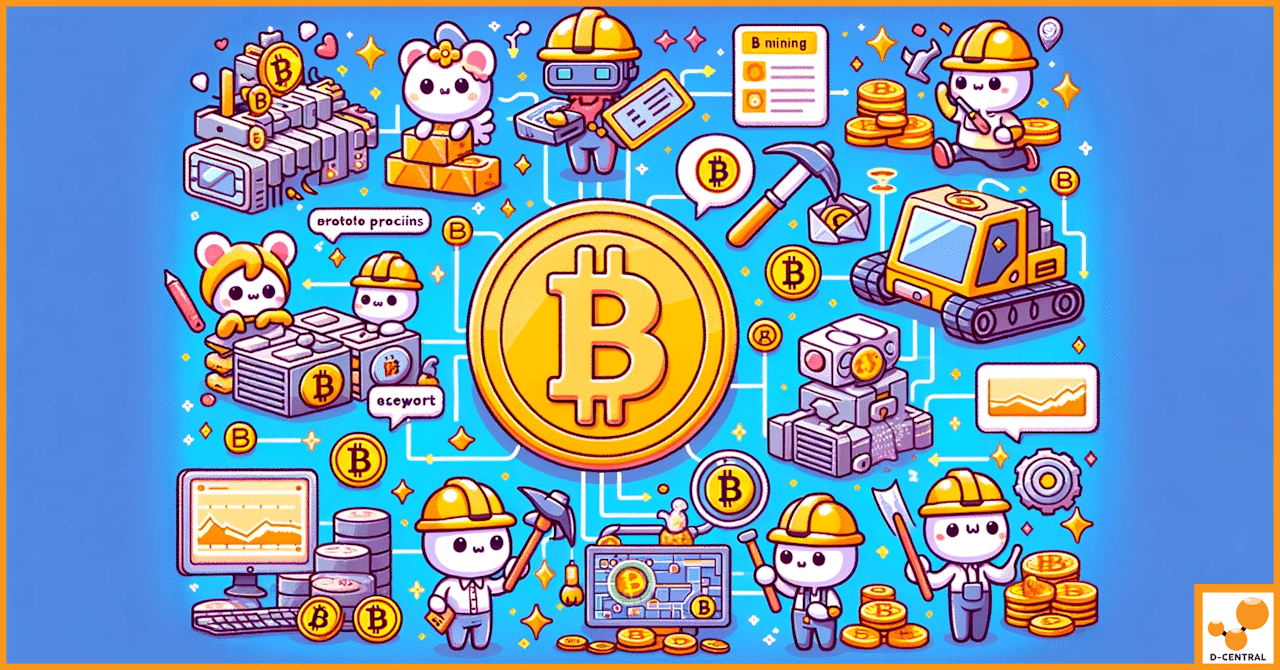
The Success Story of El Salvador’s Bitcoin Experiment
In September 2021, El Salvador embarked on a groundbreaking financial experiment that captured global attention—becoming the first country in the
4479 Desserte Nord Autoroute 440, Laval, QC H7P 6E2

Bitcoin, since its inception in 2009, has emerged as a frontrunner in the digital currency space, revolutionizing the way we perceive financial transactions and investments. As the first decentralized cryptocurrency, Bitcoin introduced a new era of financial independence and innovation, challenging traditional banking systems and introducing the world to the power of blockchain technology. Its significance extends beyond mere currency; it represents a paradigm shift towards a more transparent, secure, and decentralized financial system.
At the core of Bitcoin’s functionality and security is a process known as Bitcoin mining. This critical mechanism not only facilitates the creation of new Bitcoins but also plays a pivotal role in processing and validating transactions on the blockchain. Mining is the backbone of the Bitcoin network, ensuring integrity and chronological order of transactions, and safeguarding the network’s neutrality. By solving complex computational problems, miners contribute to the decentralization and robustness of the Bitcoin ecosystem, making it resistant to fraud and censorship.
In this exploration, we delve into the intricate workings of Bitcoin mining and its profound impact on the cryptocurrency landscape. We aim to unravel the complexities of this process, shedding light on how it underpins the entire Bitcoin network. From the technicalities of mining operations to the economic and environmental implications, this journey will provide a comprehensive understanding of Bitcoin mining, highlighting its significance as the lifeblood of the world’s premier cryptocurrency.
Bitcoin mining is a fundamental process that involves the use of sophisticated hardware and software to solve complex mathematical puzzles. This process serves two crucial purposes in the Bitcoin network: it validates transactions and secures the blockchain, the underlying technology of Bitcoin. Miners compete to solve these puzzles, and the first to succeed is rewarded with newly minted Bitcoins and transaction fees. This incentivized system not only facilitates the creation of new Bitcoins in a decentralized manner but also ensures the integrity and chronological order of the blockchain.
The journey of Bitcoin mining technology is a testament to rapid innovation and scaling. In the early days of Bitcoin, mining was possible on simple CPU (Central Processing Unit) systems, commonly found in personal computers. However, as the network grew and the mining difficulty increased, the need for more efficient mining hardware became apparent. This led to the adoption of GPUs (Graphics Processing Units), which offered greater processing power and efficiency. The relentless pursuit of efficiency didn’t stop there; it paved the way for the development of FPGAs (Field-Programmable Gate Arrays) and ultimately ASICs (Application-Specific Integrated Circuits). ASICs represent the pinnacle of mining technology, designed specifically for Bitcoin mining, offering unparalleled speed and energy efficiency. This evolution from CPU to ASIC is a reflection of the growing complexity and competitiveness in Bitcoin mining.
Blockchain is the foundational technology of Bitcoin and is essentially a public ledger that records all transactions in a secure, transparent, and immutable manner. Each block in the blockchain contains a list of transactions, and once a block is added to the chain, the information becomes a permanent part of the Bitcoin network’s history. The role of miners is to validate and add these blocks to the blockchain, using a consensus mechanism known as Proof of Work (PoW). This process not only prevents double-spending but also fortifies the network against fraudulent activities. The blockchain’s decentralized nature means that no single entity has control over the entire network, making Bitcoin a truly democratic financial system.
The Proof of Work (PoW) algorithm is the cornerstone of the Bitcoin mining process. It’s a consensus mechanism that ensures the security and validity of transactions on the Bitcoin network. PoW requires miners to solve complex cryptographic puzzles, a task that demands significant computational power and energy. The primary goal of this algorithm is to find a hash – a unique string of characters – that meets a specific condition set by the network. This condition typically involves the hash being below a certain target value, which adjusts over time to maintain a consistent rate of block creation and network stability.
The evolution of Bitcoin mining hardware is a narrative of relentless pursuit for efficiency and power. Initially, mining was feasible on general-purpose CPUs found in standard personal computers. However, as Bitcoin gained popularity and the difficulty of mining increased, the need for more powerful hardware became evident. GPUs (Graphics Processing Units), commonly used for gaming and graphic-intensive applications, were the next step in this evolution. They offered a significant improvement over CPUs due to their ability to handle parallel tasks, making them more suitable for the repetitive and high-volume nature of Bitcoin mining.
The quest for even greater efficiency led to the development of FPGAs (Field-Programmable Gate Arrays), which provided better performance than GPUs while being more energy-efficient. However, the real game-changer in the mining landscape was the introduction of ASICs (Application-Specific Integrated Circuits). ASIC miners are custom-built for the sole purpose of Bitcoin mining. They offer unparalleled processing power and energy efficiency, far surpassing the capabilities of CPUs, GPUs, and FPGAs.
ASIC miners represent the pinnacle of mining technology. They are specifically designed to compute the SHA-256 hashing algorithm used in the Bitcoin network. Over the years, ASICs have undergone significant advancements, with newer models offering substantial improvements in terms of hash rate and energy efficiency. These improvements are crucial as they directly impact the profitability and sustainability of mining operations. The latest ASIC models are equipped with cutting-edge chip designs, advanced cooling systems, and sophisticated software to optimize performance.
When comparing mining hardware, two key factors are considered: hash rate and energy efficiency. The hash rate, measured in terahashes per second (TH/s), indicates the miner’s speed and efficiency in solving the cryptographic puzzles. Energy efficiency, typically measured in joules per terahash (J/TH), determines how much power the miner consumes for each unit of hash rate. While ASIC miners offer the highest hash rate and energy efficiency, their cost and the level of technical expertise required for operation are higher compared to GPUs and FPGAs.
D-Central Technologies stands at the forefront of this technological evolution, providing state-of-the-art mining hardware to cater to various needs. Recognizing the diverse requirements of individual miners and large-scale operations, D-Central offers a range of hardware solutions, from refurbished S9 miners to the latest Antminer S19 models. Our expertise lies not only in supplying top-tier equipment but also in customizing solutions to optimize performance and efficiency. We understand the nuances of mining and are committed to helping our clients achieve the best possible outcomes, whether they are setting up a home mining rig or a large-scale mining farm.
Cloud mining is a method that allows individuals to participate in Bitcoin mining without owning or managing the physical hardware. Instead, they rent processing power from a cloud mining service provider.
Pros:
Cons:
Pool mining involves multiple miners combining their computational power to increase their chances of successfully mining a block. The rewards are then distributed among pool members based on their contributed processing power.
Benefits:
Solo Mining:
Pool Mining:
Bitcoin mining is a capital-intensive process, with costs varying significantly based on the scale and efficiency of the mining operation.
Several factors influence the profitability of Bitcoin mining:
ROI and break-even analysis are crucial for assessing the viability of a mining investment.
Bitcoin’s price volatility significantly impacts mining profitability. Rising prices can lead to increased competition as more miners are incentivized to join the network, while falling prices can make mining unprofitable for those with higher operational costs. Miners need to be prepared for these fluctuations and have strategies in place to remain profitable through market cycles.
As Bitcoin continues to grow in popularity, the number of miners vying for block rewards also increases. This competition, coupled with the design of Bitcoin’s network, leads to an increase in mining difficulty over time. The difficulty adjustment algorithm ensures that a new block is added approximately every ten minutes, regardless of the total computational power of the network. As a result, as more miners join and the network’s hash rate increases, the difficulty of mining a block also rises. This escalation in difficulty has several implications:
Bitcoin mining is energy-intensive, leading to concerns about its environmental impact, particularly regarding the carbon footprint associated with electricity generation from fossil fuels. In response, the industry is exploring sustainable mining practices:
The regulatory landscape for Bitcoin mining varies significantly across different countries and regions, presenting a challenge for miners:
This article has journeyed through the intricate world of Bitcoin mining, a cornerstone of the cryptocurrency ecosystem. We began by defining Bitcoin mining and its critical role in maintaining the blockchain, followed by an exploration of the Proof of Work algorithm that underpins this process. We delved into the evolution of mining hardware, from the early days of CPUs to the current dominance of ASIC miners, and examined the advanced mining techniques and strategies that have emerged, including cloud and pool mining.
The financial aspects of Bitcoin mining were analyzed, highlighting the factors that influence profitability, such as electricity costs, hardware efficiency, and Bitcoin market fluctuations. We also addressed the significant challenges facing the mining industry today, including the increasing difficulty of mining, environmental concerns, and the complex regulatory landscape.
Bitcoin mining continues to be a vital component of the cryptocurrency world. It’s not just about creating new bitcoins; mining is essential for processing transactions and maintaining the security and integrity of the Bitcoin network. As the network grows and evolves, the role of miners becomes increasingly crucial in sustaining the decentralized ethos of Bitcoin.
For those intrigued by the world of Bitcoin mining or looking to enhance their existing operations, D-Central Technologies offers a gateway to success. Our expertise in providing state-of-the-art mining hardware, from efficient ASIC miners to customized mining solutions, positions us as a leader in this field. We understand the nuances of mining and are committed to helping our clients navigate this complex landscape.
We invite you to explore the range of services and products offered by D-Central Technologies. Whether you’re starting your mining journey or seeking to optimize your current operations, our team is equipped to support your goals with our extensive knowledge and commitment to innovation. Visit us at D-Central Technologies to discover how we can help you achieve success in the dynamic world of Bitcoin mining.
What is Bitcoin mining?
Bitcoin mining is the process by which new Bitcoins are created and transactions are verified and added to the blockchain. It involves solving complex mathematical puzzles using sophisticated hardware and software.
How does Bitcoin mining work?
Miners validate and process transactions by solving cryptographic puzzles to discover a new block, which is then added to the blockchain. Miners who successfully add a block are rewarded with newly minted Bitcoins and transaction fees.
What has been the evolution of Bitcoin mining technology?
Bitcoin mining technology has evolved from CPU mining to ASIC mining, with each progression bringing about more power- and cost-efficient solutions. This evolution is driven by the increasing difficulty of mining and the competitive nature of the process.
What is an ASIC miner?
An ASIC (Application-Specific Integrated Circuit) miner is a device designed specifically for the purpose of mining Bitcoin or other cryptocurrencies, offering high processing power and energy efficiency.
How does joining a mining pool benefit individual miners?
Joining a mining pool allows individual miners to combine their computational power, increasing their chances of successfully mining a block and earning rewards. Rewards are then distributed among pool members proportionally, offering more stable and consistent returns.
What factors affect the profitability of Bitcoin mining?
Profitability of Bitcoin mining is affected by Bitcoin’s market price, network mining difficulty, the miner’s hardware efficiency and hash rate, and electricity costs.
What are some sustainable mining practices in Bitcoin mining?
Sustainable mining practices include using renewable energy sources, capturing and reusing the heat generated by mining equipment, and situating mining operations in cooler climates or regions with excess renewable energy.
What challenges do Bitcoin miners face?
Bitcoin miners face challenges such as increasing network mining difficulty, environmental concerns regarding energy consumption, and navigating the diverse regulatory landscape across different regions.
How can D-Central Technologies help with Bitcoin mining?
D-Central Technologies provides state-of-the-art mining hardware solutions, ranging from refurbished to the latest mining models, and offers customized advice and products to optimize mining operations and efficiency.
DISCLAIMER: D-Central Technologies and its associated content, including this blog, do not serve as financial advisors or official investment advisors. The insights and opinions shared here or by any guests featured in our content are provided purely for informational and educational purposes. Such communications should not be interpreted as financial, investment, legal, tax, or any form of specific advice. We are committed to advancing the knowledge and understanding of Bitcoin and its potential impact on society. However, we urge our community to proceed with caution and informed judgment in all related endeavors.
Related Posts

In September 2021, El Salvador embarked on a groundbreaking financial experiment that captured global attention—becoming the first country in the

Bitcoin, the first and most renowned cryptocurrency, has revolutionized the financial landscape since its inception in 2009. At its core,

Bitcoin mining is a fundamental process that underpins the operation of the Bitcoin network. It involves the use of powerful